The number of leprosy, or Hansen’s Disease cases in Florida during the first half of 2015 is nearly what the Sunshine state saw in all of last year as Flagler County reported the latest case on Friday. The case was reported from the city of Bunnell.

To date in 2015, Florida has seen nine leprosy cases, compared to the entirety of 2014, which saw 10 cases.
Brevard County has reported the most this year with three, with Volusia chalking up two and Flagler, Indian River, Lake and Polk counties all seeing one a piece.
Although the source of the infections are not specified, the link between the zoonotic infection and armadillos is pretty well documented. A 2011 genetic study on this exact topic concluded that armadillos may be a source of infection in the Southern United States.
“Leprosy has been feared throughout human history, and there are still regions in several countries, including in the southern United States, where new cases of this disease continue to occur,” said Richard W. Truman, Ph.D., Research Scientist at the National Hansen’s Disease Program (NHDP). “The results of this study will help us better understand where some of these infections originate.”
Armadillos are the only other known natural hosts of leprosy bacteria.
The NHDP does note that the risk of transmission from animals to humans is low, but armadillos are wild animals and should be treated as such, with all proper precautions.
The United States sees approximately 150 to 250 leprosy cases annually. 213 new cases were reported in the U.S. in 2009 (the most recent year for which data are available).
During the ten-year-period of 2004 to 2014, Florida reported 92 cases, averaging less than 10 per year.
Leprosy is a chronic bacterial disease that primarily affects the skin, peripheral nerves and upper airway. Feared as a highly contagious and devastating disease, it is well established that Hansen’s disease (leprosy) is not highly transmissible, is very treatable, and, with early diagnosis and treatment, is not disabling.
Leprosy remains the most misunderstood human infectious disease. The stigma long associated with the disease still exists in most of the world and the psychological and social effects may be more difficult to deal with than the actual physical illness.
Related: Cryptosporidium: How does Florida stack up?
Related: Florida Vibrio: Hillsborough County reports 2nd death


4 thoughts on “Flagler County reports leprosy case, 9th case in Florida in 2015”